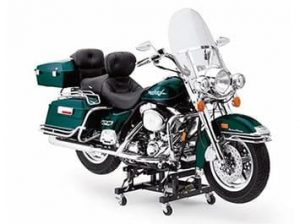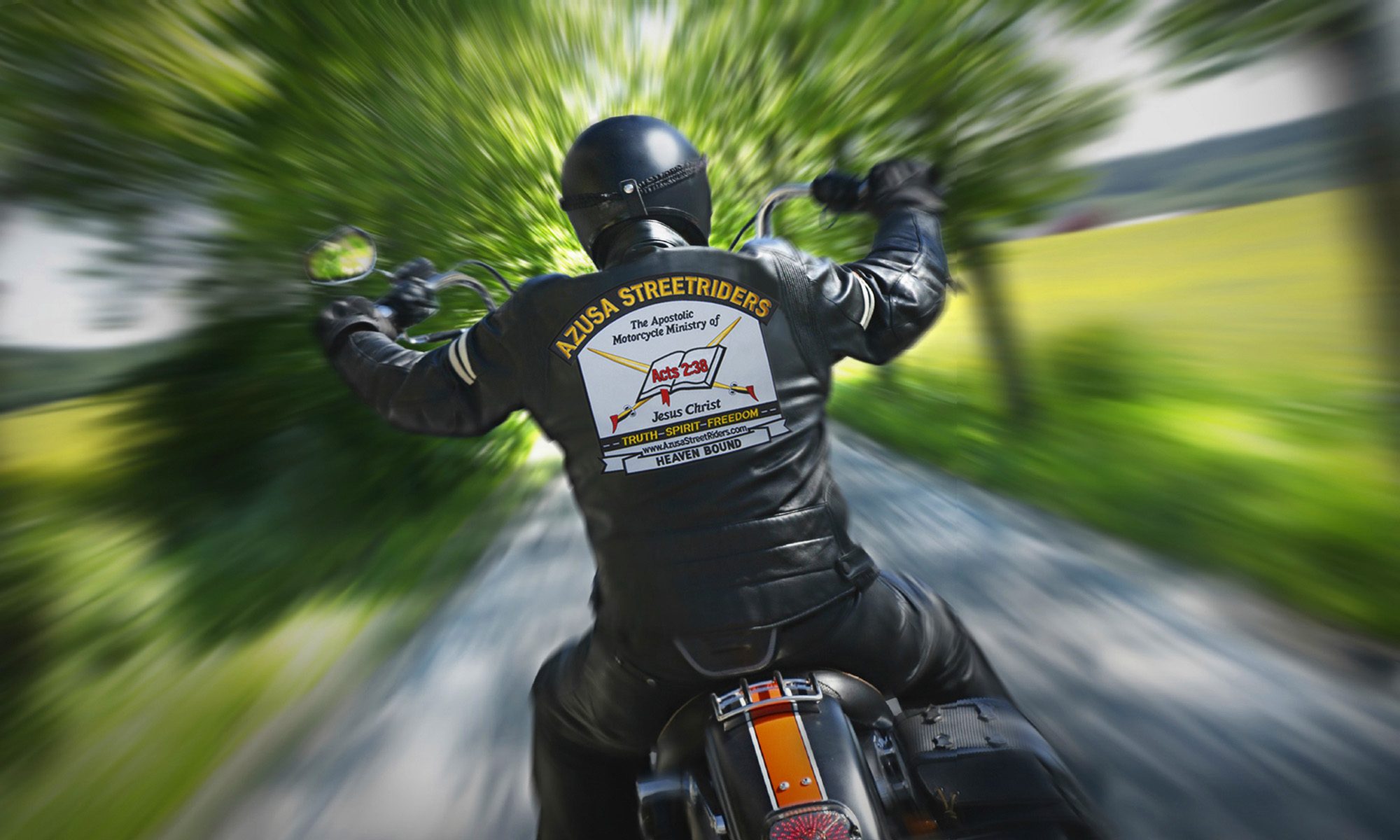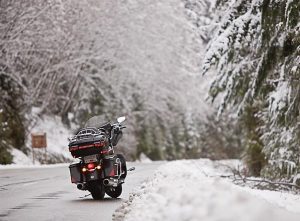
Motorcycle riders are known for their rituals. Those ritualistic tendencies come out when the riding season draws close. Most riders take one last big epic ride before they park their bikes for the winter and freezing temperatures.
Any doubts can be answered in the owner’s manual which came with your ride or online or with the motorcycle storage tips below. And after one successful winter, every winter after that will be much
“Riders start bringing their bikes in for winter storage and custom design work right after Labor Day.”
Some riders see winter as the ideal time to make motorcycle customizations or enhancements they have meant to get done. Some riders drop their bikes off at dealerships in the winter and pick up their transformed custom pieces in the spring.
If you enjoy the ritual and want to self-storage it alone, here are essential tips to prepare your bike for winter storage.
How to Winterize a Motorcycle for Storage
A proper motorcycle winterization checklist helps ensure your motorcycle remains in good condition and is ready for use once the warmer weather returns.
Here’s a step-by-step guide for how to store motorcycles for winter:
Fluids
Freshen up those fluids. That means all of them: motor oil, clutch, brake, and coolant.
Although, this depends on how long it’s been since the last time you changed your fluids. If the last time you changed your clutch and brake fluid was a month ago, and a few hundred miles driven, stick to changing the oil. My rule of thumb is I change everything before I put my bike away for the winter regardless if I had changed the fluids a month or two prior.
Changing fluids regularly is essential because they contain contaminants from regular usage, which become corrosive over time and can destroy rubber seals. In addition, the DOT4 brake fluid absorbs water and needs to be changed every two years.
Change the oil
The last thing you want is your motorcycle sitting idle all winter, filled to the brim with oil contaminated with solvents and sediments. It might not run if the bearings have been corroded or damaged.
Changing the oil is a vital and simple step to take to avoid forking out money down the road.
Tenderize the battery
How to store a motorcycle battery for winter? Some riders recommend starting their bike every week during the winter and letting it run.
A much better solution, however, is to clean the battery electrodes and hook them up to a battery tender (or trickle charger) for the entire duration of the winter. Not only should you use a battery tender during the winter—but one should be used all the time after each ride.
If you properly winterize your motorcycle battery, it will help extend the longevity of the battery.
Buy a FOB battery to have at the ready. For those that use a key Fob. Or use a Fob for add on LED glow lights.
While we are on batteries, if your bike won’t start in the spring, it may be for one of two reasons: you forgot your pin or need to replace your FOB battery.
There’s nothing you can do about it, but your FOB battery will attempt to communicate with your bike all winter. By the time spring rolls around, you’ll inevitably need to replace it.
You should keep one in the drawer of your tool box in your garage next to your bike. And carry a spare on your bike.
Check your tires
How long do bike tires last in storage? This largely depends on the respective tire wear going into storage and how the bike is stored.
In addition to checking for even wear on your tires, ensure they have enough tread remaining. Ensure the tires are not worn to the extent that the wear bars are exposed. If you have any questions, contact your dealer. Also, check their inflation with an accurate gauge.
Your owner’s manual and VIN label lists the proper tire inflation pressures. You can put your bike on front and rear stands, lifts, or dollies to keep your motorcycle upright all winter. This will also relieve pressure on the tires.
If you do not use a lift, move the motorcycle at least once a month to prevent flat spots on the tires.
Prevent rust: scrub, wash, dry, and wax
Start with the dirtiest part of your bike. That means the chain (if your bike is equipped with one) and brakes. You’ll want a grunge brush and an O-ring safe degreaser for your chain.
For your brakes, you’ll want a disc cleaner. Inspect everything while cleaning so that you don’t discover any surprises during the spring. After that, wash and dry your bike. You especially want to do this if you cover your motorcycle because any moisture on your motorcycle can cause corrosion and mold.
Lastly, Wax/ Polish/or Ceramic coat your paint and treat any chrome as well. This will add extra protection for your bike while it’s in storage. Plus, it’ll be spotless when you take your bike out in the spring.
If you have leather seats or any leather items, treat them as well.
Wax and lubricate your chain if you have a chain drive.
Taking care of your chain before storage will extend its life.
Every 500 miles of street riding and every 200 miles of adventure/off-road riding should be followed by cleaning and waxing/lubricating your bike’s chain. Follow the guidance in your owner’s manual.
Begin by warming your chain with roughly five miles of riding. This will allow the lube to dissolve more effectively and enter the O-ring chain. Wipe off any unnecessary wax or lube.
Inspect the Belt Drive
Belt drives are cleaner than chain drives and require minimal inspection and adjustment. Before putting your bike away for the winter, inspect the inside and outside of the belt and look for chips, cuts, fraying, or missing teeth.
As is the case with a chain drive, proper tension is important. Be sure you consult the owner’s or service manual for the slack specification, measuring technique, and point at which to take the measurement.
Shaft drive basically zero maintenance. Check your owner’s manual for shaftdrive.
Prep the exhaust pipe
You’ll want to stuff any openings in your bike so that creatures don’t make their homes in them. This is especially important when keeping your bike outside or in a barn or shed. Or if you have holes or cracks in your garage where rodents can get in.
Some people use plastic bags for this purpose but spend the money on a muffler cover or any other product designed expressly for this purpose. Just remember to remove these items before your next ride.
Store on centerstand and/or stands if possible
If your bike has a centerstand, use it. But even better would be to get a motorcycle stand to keep both wheels off the ground.
This way, you don’t have to rotate the wheels to avoid flat spots. This motorcycle storage lift also prevents the suspension from working overtime and extends the suspension’s lifespan.
Use the correct cover
Should you cover your motorcycle?
While often used, a plastic cover is not the best motorcycle cover. It will trap moisture, potentially causing rust, corrosion, and mold. Instead, invest in an affordable, breathable cover.
Store in a well-ventilated area
The best place to store your bike is somewhere well-ventilated indoors. This way, air will circulate, and moisture or condensation won’t collect under your cover.
Just ensure there’s no fertilizer or chemicals around your bike since they can end up corroding your motorcycle.
What are common winterizing and storage mistakes?
Don’t start your bike up every week
Just turning your bike on in the garage isn’t a good idea.
If your bike is not brought up to the full operating temperature in cold temperatures, water may condense and end up in places where it doesn’t belong (when you ride your bike, the moisture gets cooked off, and your battery receives a recharge).
If you are one who likes to start your bike up in the winter to well just hear it. Start your bike and at least let it iddle for 20 minutes. This will then burn off any moisture.
Don’t drain your fuel tank
Don’t leave your gas tank empty unless you want it susceptible to corrosion and dried out seals. Instead, leave it full of gas and a quality fuel stabilizer additive. This is a vital step.
Without this treatment, the fuel turns into a crystalized, hard product and can clog carburetors and fuel injectors.
Don’t store a dirty bike
You’ll want to clean your motorcycle of road grit, grime, and bugs because they’ll eat away at any clear coat, anodized aluminum, polished metal finish, and stainless steel.
If you live in an area with salt or brine on the roads, you’ll also want to clean your bike since that’ll do a number on metal and rubber parts.
Before putting your bike away for winter, a final wash and wax is a good idea.
Don’t use a cheap cover or a tarp
You will want proper protection for your bike – especially if not stored in an enclosed storage unit. A poorly made cover may trap water, slip off, or chafe against the paint.
The result is that your bike will come out looking worse than when it went in.
Should I cancel my motorcycle insurance if I’m not riding in the winter?
There are several reasons not to cancel your motorcycle insurance policy during the winter months.
Warm winter days
While the seasons may change, unseasonably warm and clear winter days are perfect for a motorcycle ride. An uninsured ride, however, could expose you to an unforeseen incident and potential legal risk.
Don’t assume motorcycle thieves take the winter off either.
Unplanned damage while in storage
A significant winter storm, a fallen tree, or the possibility of fire should all be considered when evaluating the cancellation of your insurance policy. Remember, insurance is designed to protect you from unexpected and unplanned events. Without it, this type of incident may result in a total loss.
Common motorcycle winterization questions
Do you have to winterize a motorcycle?
Full winterization might not be necessary if you live in a region with mild winters and continue to ride your motorcycle regularly.
Still, it’s strongly recommended if you won’t be riding it for an extended period during the colder months, especially in areas where temperatures drop significantly or where there’s a lot of moisture.
Not winterizing can lead to various issues, such as:
Battery drain
Fuel degradation
Tire damage
Corrosion and rust
Oil contamination
etc.
Can you store a motorcycle outside in winter?
Yes, you can store a motorcycle outside in winter, but doing so presents challenges and potential risks to the bike’s condition. If you must store your motorcycle outside during the winter, take the following precautions to minimize potential damage:
Use a quality cover
Check on it periodically
Lift the bike off the ground
Choose a sheltered location
Cover exhaust pipes and air intake
Ensure your motorcycle insurance remains valid even if you aren’t riding it
How often should I start my motorcycle in the winter?
If you’ve properly winterized your bike, there’s no need to start it during the winter. It is recommended to avoid starting the motorcycle periodically through the winter if you’re not going to take it for a full ride, as short starts can introduce condensation into the engine and exhaust.
If you feel the need to start it, ensure you:
Let It Reach Operating Temperature: This helps burn off condensation and ensures the oil circulates thoroughly.
Ride It: Instead of just letting it idle, take it for a ride long enough to charge the battery and bring all parts to operating temperatures. This is often not feasible due to winter road conditions, but it’s the best method if you’re set on running the bike.
If you’re concerned about the battery, it’s better to remove it and keep it on a trickle charger or battery maintainer indoors.
Can you ride a motorcycle in winter?
Yes I used to be a very long time winter warrior.
You can ride a motorcycle in the winter, but it has increased challenges and risks. If you’re considering winter riding, here are some factors to consider and winter weather riding tips to follow.
Make sure you have the right winter gear on. The key is to stay warm. Keep the wind off of you. Keep an eye on the road conditions watch out for black ice and any salt clumps and slush. Try not to ride at night.
How much does it cost to store a motorcycle?
The cost to store a motorcycle varies depending on several factors, including location, type of storage, duration, and additional services or amenities offered.
Can I store the motorcycle in a storage unit during the winter?
Yes, storing a motorcycle in a storage unit during the winter is an option. If you don’t have a garage and prefer not to leave your motorcycle outside, opting for a storage unit offers protection from the elements, potential theft, and other potential damages. Here are some key features to look for if you are thinking of using a storage unit:
Cost
Security
Accessibility
Size of the unit
Ground protection
Climate-controlled storage
How to de-winterize a motorcycle?
When spring arrives, thoroughly check the bike before hitting the road to ensure everything is in good working order, including:
tire pressures
fluids
brakes
other systems
Refer to your motorcycle’s owner manual for specific requirements or recommendations.
The bottom line on winter motorcycle storage
If you live in a climate with a winter, you will have to store your bike. Luckily, storing a motorcycle for the winter is incredibly easy and something you can do independently after reading a manual, an article, or just watching a few YouTube videos.
If you go with a dealer to store your bike, they will take care of all the necessary maintenance to ensure your ride is ready when the weather improves.
But, if you want to go it alone, make winterizing your ride a yearly ritual so you can spend less time in the garage and more time on the road. See your motorcycle’s owner’s manual for additional instructions and steps when placing or removing your motorcycle from storage.
For those riders in the deep south or out west that don’t have to deal with the freeze of winter. Well just keep on riding LoL
Michael Theodore (Theo)
International President











